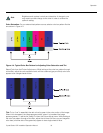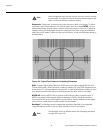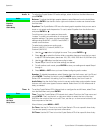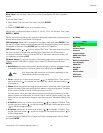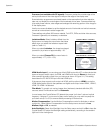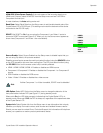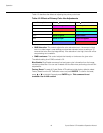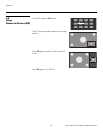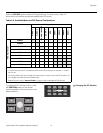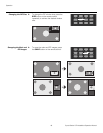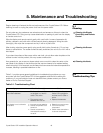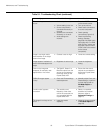
Operation
Crystal Series LCD Installation/Operation Manual 43
PRE
L
IMINAR
Y
•Tint
• Sharpness
•Gamma
• Color temperature selection (5400, 6500, 8500 or Custom)
To save image settings to a preset, select Save Settings from the Picture Adjust menu
and select “Custom,“ “ISF Day” or “ISF Night.”
Restore Settings: To recall a preset, choose Restore Settings from the Picture Adjust
menu and select “Custom,” “ISF Day” or “ISF Night.” Or, use the corresponding buttons
on the remote control.
White Balance: To remove any trace of color from the white areas of the displayed
image, set the Color Temp. to Custom. Then, choose
White Balance from the ISF
Calibration menu and press ENTER.
•Gain: Use the Gain controls to correct color imbalances in the bright areas of the
image. A good way to do this is to use a test pattern consisting mostly of solid white
areas, such as an 80 IRE “window” pattern. If the white areas contain traces of red,
green or blue, decrease the Gain for that color.
•Offset: Use the Offset controls in the White Balance sub-menu to correct color
imbalances in the dark areas of the image. A good way to do this is to use a test
pattern consisting mostly of dark gray areas, such as a 30 IRE “window” pattern. If the
gray areas contain traces of red, green or blue, decrease the Offset for that color.
CMS Hue/CMS Saturation/CMS Luminance: Use the Color Management System
(CMS) controls to customize the stored color space characteristics. To do this, select
CMS Hue, CMS Saturation or CMS Luminance from the ISF Calibration menu. Then, use
the or button to select a component color (Red, Yellow, Green, Cyan, Blue, or
Magenta) and press ENTER.
For each component color, you can adjust the following:
• CMS Hue: This control adjusts the red/green color hue for true color reproduction of
video signals. For best results, adjust the hue while displaying an external color bar test
pattern (Figure 4-4).
Changing the hue of a component color affects the gamut (range) of possible colors.
For example, changing the value for red moves the color closer to either yellow or
magenta, which in turn affects all displayed colors having a red component.
White Balance
R Gain 256
G Gain 256
B Gain 256
R Offset 0
G Offset 0
B Offset 0
Any white balance adjustments you make here are automatically
stored as a “Custom” color temperature. The White Balance
settings for the 5400K, 6500K and 8500K color temperatures are
factory-set and cannot be changed. Always set the Color Temp.
to Custom before making any white balance adjustments, so
you can see how those adjustments affect the image.
Note
CMS Hue
R.Hue 50
Y.Hue 50
G.Hue 50
C.Hue 50
B.Hue 50
M.Hue 50



